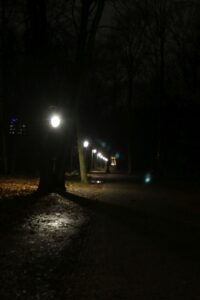How to light a street safely – and how to effectively blind the people
I often read or hear that women who walk around at night want lots of light so they can see everyone who approaches them and spot a potential danger early enough to prepare themselves. This is usually said by a man. Well, I’m a woman, and I frequently walk around after dark. Sometimes I walk around a lonesome forest, or even an African camp during a blackout, sometimes in a city, mostly in Berlin. So I’m confident to say: yes I want enough light to see if there is an obstacle (or a snake) in my way and I definitely want to see if somebody is apporaching me. The only problem is that with modern street lights, there are many situations where I can’t see the person walking towards me. And the reason for this is that there is too much light involved. Why?
A short time ago Jim King, and Steve and Amelia Goldberg from the Houston Astronomical Society made a video that shows how well you can see a pedestrian who walks underneath an unshielded and a shielded light:
As you can see, the pedestrian entirely disappears when walking under the unshielded light. The reason is that the bright light produces glare which is effectively blinding us. Please note that the second ‘unshielded light’ is a reflection of the real light on a building.
Another problem are harsh contrasts created by a light source that is too bright. This video by The Dark Ranger shows that very nicely:
The street light in this video is so bright that we can’t see what’s in the shadows. But whoever is in the shadows can very nicely see us.
 Some while ago I walked through Berlin Tiergarten, a big park in the center of Berlin. It is home to many homeless people and wild boar, and walking there after 9 pm was an awkward feeling. I started my walk on a well lit alley with unshielded lights. I was able to see a long way ahead and spot bikers coming towards me. What I was not able to see was if anything was in the bushes next to me. If somebody would have wanted to ambush me, he would have had a nice advantage.
Some while ago I walked through Berlin Tiergarten, a big park in the center of Berlin. It is home to many homeless people and wild boar, and walking there after 9 pm was an awkward feeling. I started my walk on a well lit alley with unshielded lights. I was able to see a long way ahead and spot bikers coming towards me. What I was not able to see was if anything was in the bushes next to me. If somebody would have wanted to ambush me, he would have had a nice advantage.
I then left the alley and walked along a meadow without lights. Since the park is next to one of the brightests spots in Berlin, the Sony Centre at Potsdamer Platz, it was still bright, but the contrasts were softer. I was able to see a wide area and even look into the shrubs and so I had a good idea what was going on.
One week later I did the same walk with a group of people and they had the same experience. It’s much easier to see if the light is less bright and not produced by single bright luminaires. So when we talk about lighting for safety, we should think about light levels high enough to enable us to see in the dark but low enough to allow dark adaptation of our eyes to see a wider area. And we must, by all means, reduce glare, because it doesn’t help our vision at all, but blinds us and is a waste of light and energy.